Desk Research Report Samples
-
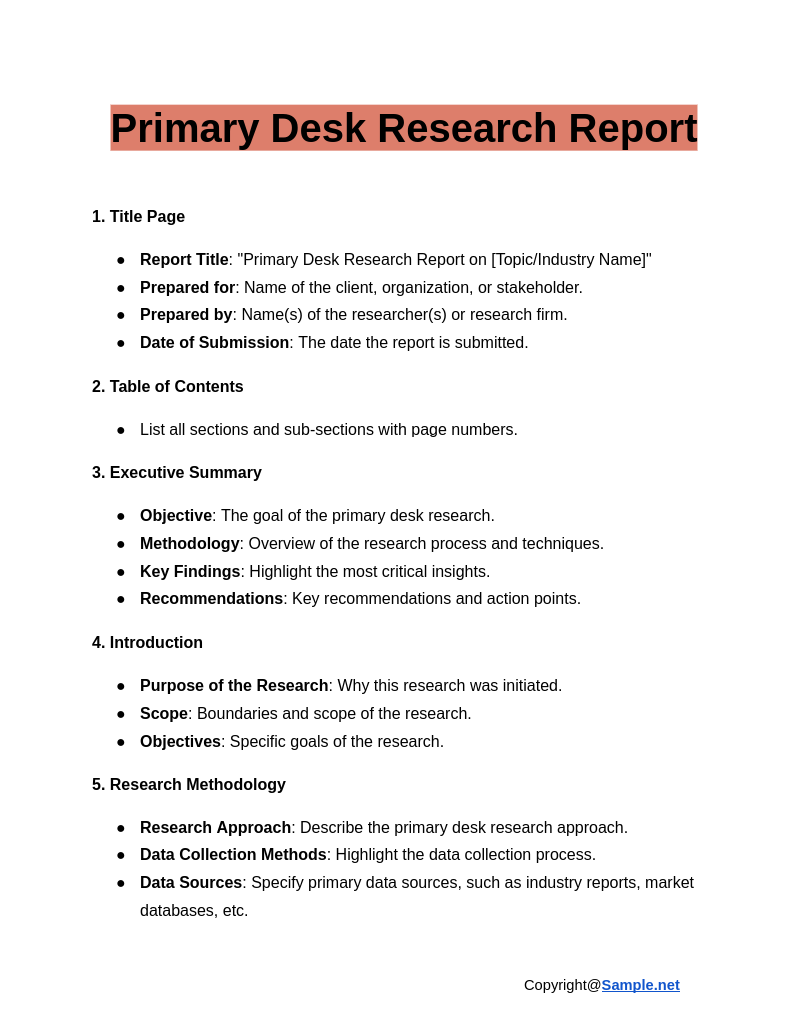
Primary Desk Research Report
download now -
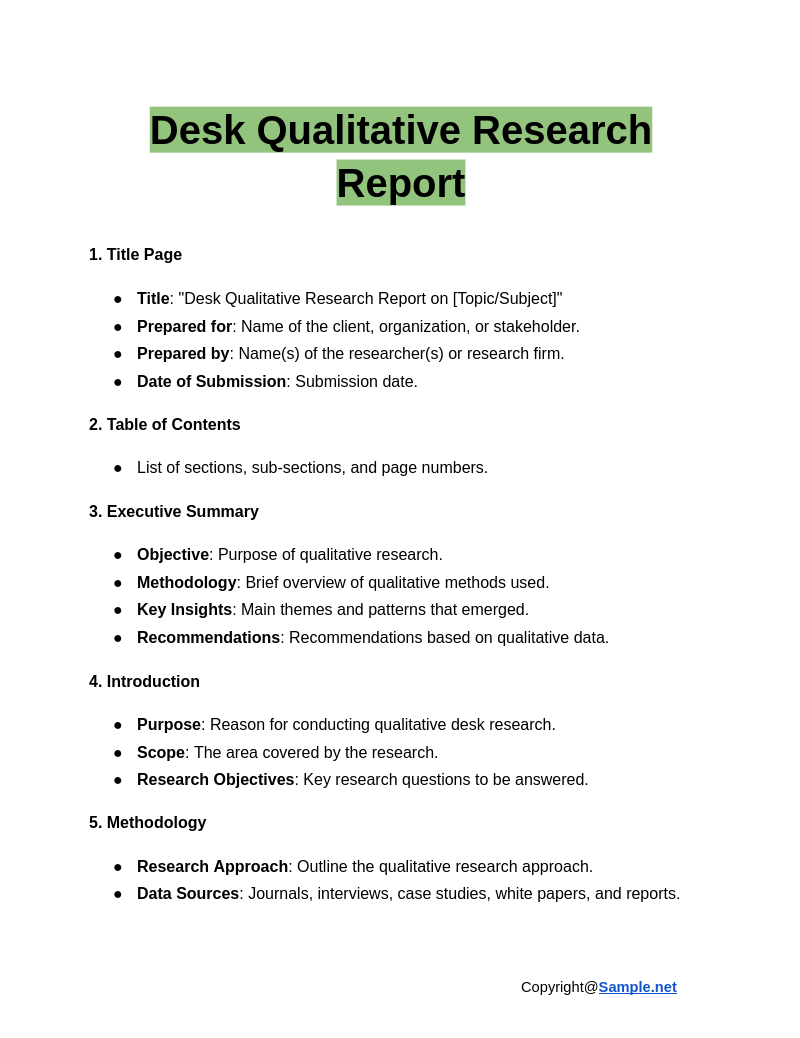
Desk Qualitative Research Report
download now -
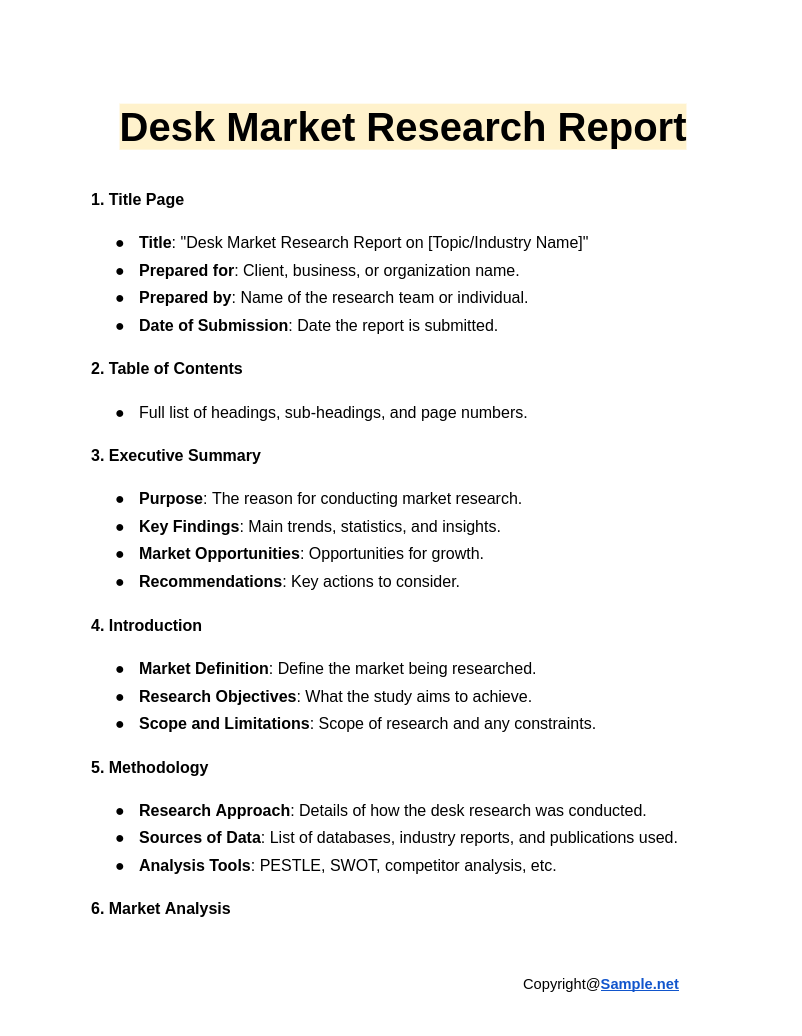
Desk Market Research Report
download now -
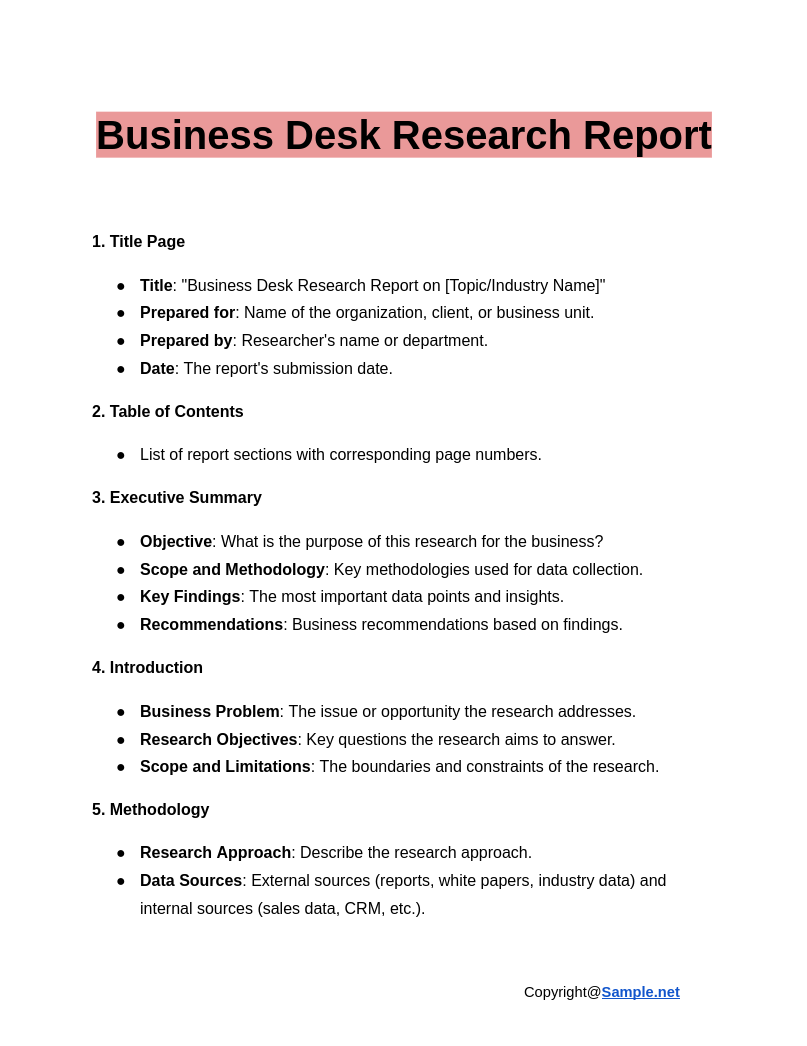
Business Desk Research Report
download now -

Desk Research Report
download now -

Sample Desk Research Report
download now -

Literature Review And Desk Research Report
download now -

Desk Research Report from Portugal
download now -
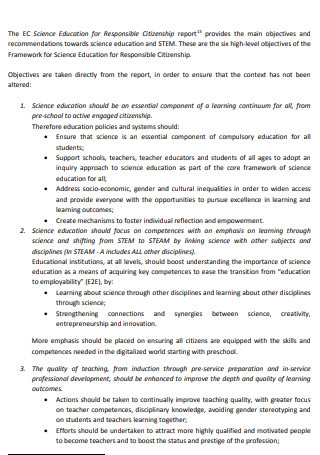
Report on Desk Research
download now -

Desk Research Report on Pedagogic
download now -
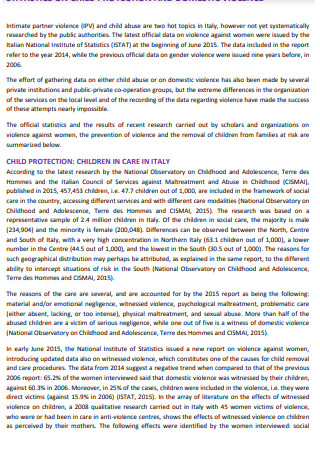
Desk Research Report Example
download now
FREE Desk Research Report s to Download
Desk Research Report Format
1. Title Page
2. Table of Contents
3. Executive Summary
4. Introduction
5. Research Methodology
6. Literature Review
7. Data Analysis and Findings
8. Insights and Key Takeaways
9. Conclusions and Recommendations
10. References and Bibliography
11. Appendices
Desk Research Report Samples
What is a Desk Research Report?
Purposes of a Desk Research Report
How to Write a Desk Research Report
FAQs
Why is it called desk research?
What are the benefits of secondary research?
What are the drawbacks of desk research?
How is desk research used in market analysis?
What challenges do researchers face in desk research?
How is desk research used in market analysis?
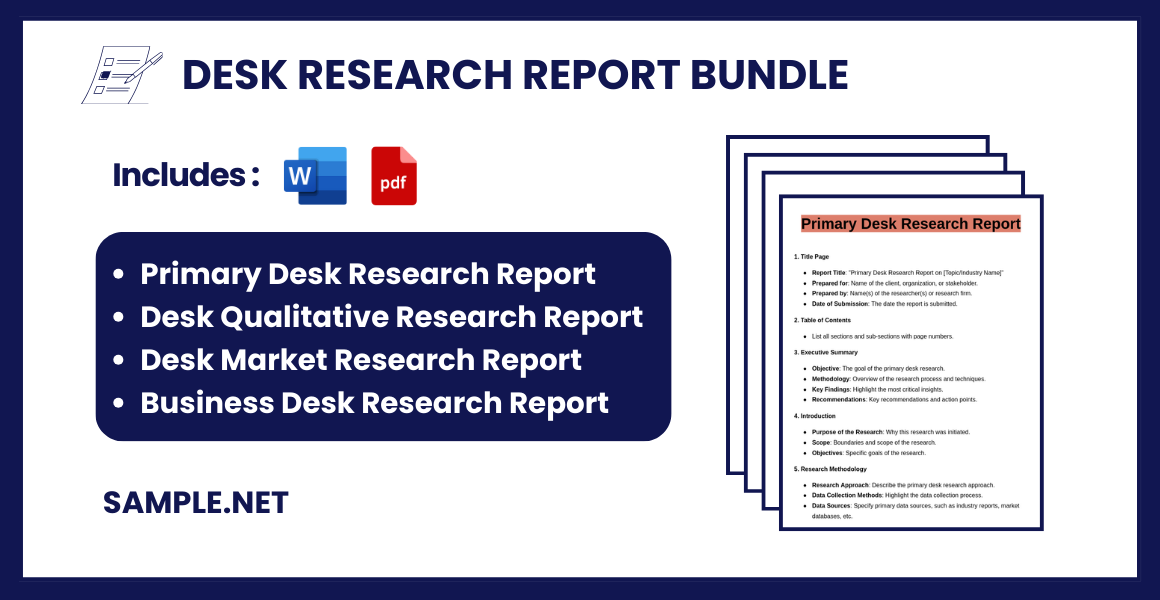
Download Desk Research Report Bundle
Desk Research Report Format
1. Title Page
- Title of the Report: Clearly specify the title of the desk research.
- Prepared for: Name of the organization, client, or stakeholder requesting the report.
- Prepared by: Name(s) and role(s) of the researcher(s) or organization conducting the research.
- Date of Submission: Include the date when the report is completed and submitted.
2. Table of Contents
- List all sections, sub-sections, and page numbers for easy navigation.
3. Executive Summary
- Purpose: The objective of the desk research.
- Methodology: Briefly describe the research process.
- Key Findings: Highlight the most critical insights, trends, and data points.
- Conclusions and Recommendations: A summary of the conclusions and proposed recommendations.
4. Introduction
- Background: Provide context about the topic being researched.
- Research Objectives: Define the specific goals and objectives of the desk research.
- Scope and Limitations: Indicate the boundaries of the research, such as geography, time period, and other constraints.
5. Research Methodology
- Data Sources: List the primary sources of information (databases, reports, industry publications, etc.).
- Data Collection Approach: Describe how the information was gathered and which methods were used (online searches, academic research, industry publications, etc.).
- Analysis Techniques: Explain any techniques used to analyze and validate the data (qualitative analysis, trend analysis, etc.).
6. Literature Review
- Review of Previous Research: Summarize key information from past studies and reports.
- Key Theories/Concepts: Highlight relevant theories, concepts, or frameworks that support the research.
- Research Gaps: Identify any gaps in existing knowledge that the current research aims to address.
7. Data Analysis and Findings
- Introduction to Findings: Provide a brief overview of the key findings.
- Analysis by Topic/Theme: Organize data under specific themes or categories.
- Statistical Data: Include charts, graphs, and tables to present key data points.
- Case Studies (if applicable): Provide case studies, industry examples, or comparative analysis.
- Trends and Patterns: Highlight notable trends, shifts, or emerging opportunities.
- Supporting Evidence: Reference specific sources that support the findings.
8. Insights and Key Takeaways
- Summary of Key Insights: Highlight the most critical insights from the data analysis.
- Opportunities and Challenges: Identify possible opportunities and key challenges from the research.
- Market Trends: Provide a summary of current trends impacting the industry or subject of research.
9. Conclusions and Recommendations
- Summary of Findings: Recap the key results of the research.
- Conclusions: Draw conclusions based on the research objectives.
- Strategic Recommendations: Provide actionable recommendations for the organization or client.
- Impact on Business Decisions: Explain how the insights can influence decision-making or strategic planning.
10. References and Bibliography
- List of Sources: Provide a full list of all the references, reports, articles, and online resources used during the research.
- Citations: Use a standardized citation format (APA, MLA, Chicago, etc.).
11. Appendices
- Supplementary Information: Include any additional charts, tables, or data that support the report.
- Glossary of Terms: Define key terms or industry-specific jargon used in the report.
- Research Tools and Templates: Attach any templates, survey questions, or tools used to collect data.
What is a Desk Research Report?
A Desk Research Report is a document that compiles and analyzes data from existing secondary sources, such as reports, industry publications, academic papers, and online resources, to offer insights, trends, and analysis without conducting new field research. You can also see more on Process Report.
Purposes of a Desk Research Report
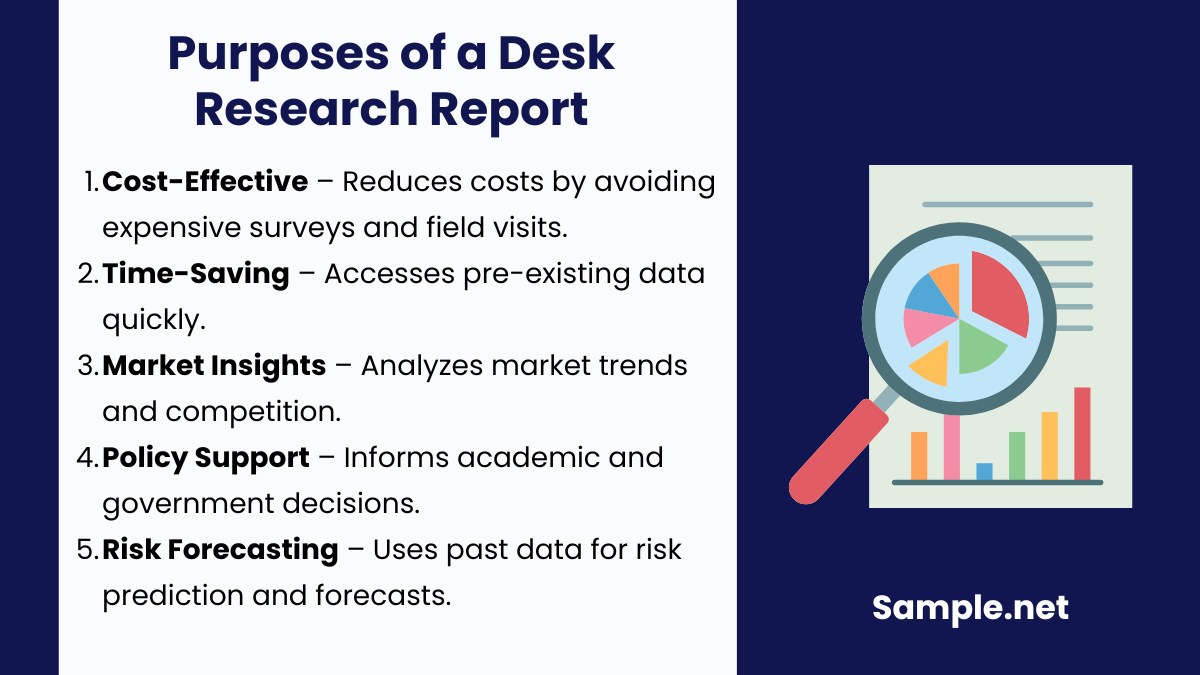
1. Cost-Effective Data Collection – Desk research eliminates the need for expensive surveys, interviews, and field visits, reducing operational costs.
2. Time-Saving Approach – Since the data is already available, organizations can access information faster than conducting original research.
3. Supports Market Analysis – Businesses use desk research to understand market trends, consumer behavior, and competitive landscape. You can also see more on Research Progress Report.
4. Academic and Policy Research – Educational and governmental bodies use desk research reports to base policy decisions or support research studies.
5. Risk Assessment and Forecasting – Companies analyze historical data to predict potential risks and develop forecasting models. You can also see more on Research Investigation Report.
How to Write a Desk Research Report
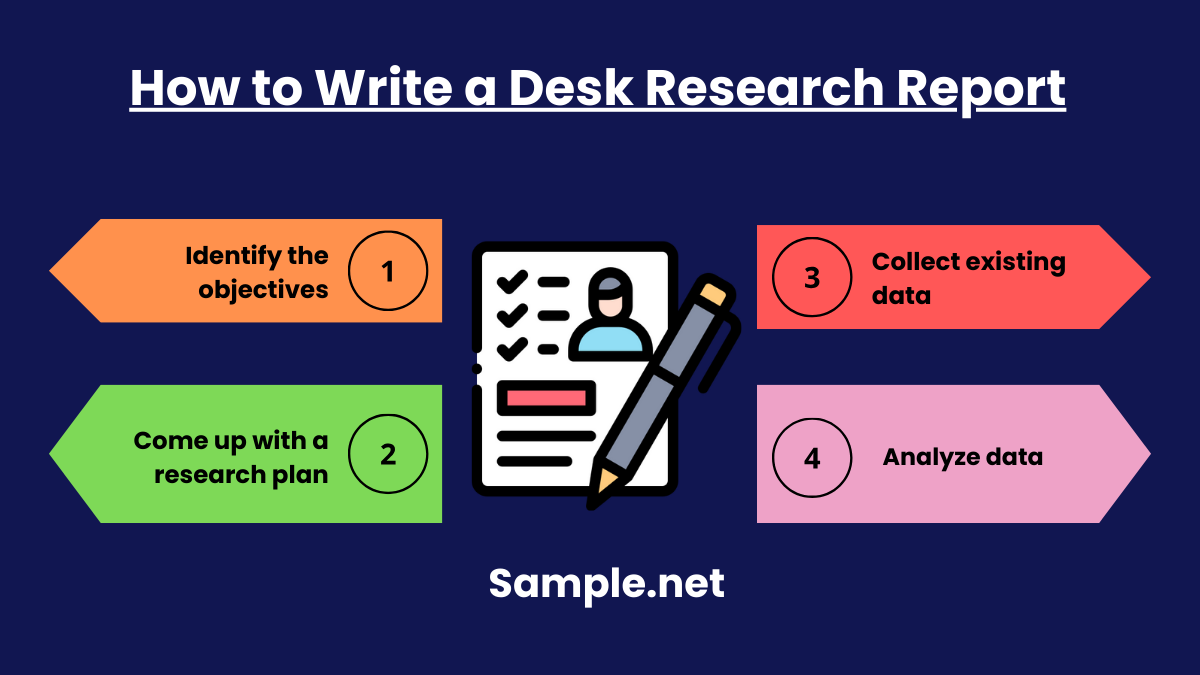
After clarifying what a desk research report is and the types or methods of data collection defined, it is finally time to proceed to know how to write a desk research report format. Keep in mind that you don’t have to worry about starting from scratch because we have provided you with templates that you can use. All you have to do is follow the steps in filling them out.
Step 1: Identify the objectives of your research.
If you have a specific goal in mind for your research, it will be much easier to conduct desk research. If you’re not sure what your research’s goal is, make a list of all the questions you wish to investigate. The goal of your study should be to obtain answers to all of these questions. Follow the logic of progressing from broad research to a specific research topic. Finally, you should have a general concept of how much data you want to gather so you know when to go on to the next stage. You can also see more on Scientific Research Report.
Step 2: Come up with a research plan.
This stage may go against your preconceived notions about desk research. The majority of individuals assume that desk research is done without a strategy. But believe me when I say that establishing a research strategy will make your study much easier. Choose a research technique and a tool for collecting and analyzing your study data. Identifying research sources is part of this process. Reduce the number of information sources you use to those that will give the most relevant facts and information for your study. Be resourceful and use all of the tools at your disposal to get the information you need in the most efficient way possible. However, in other situations, laborious research-based mostly on web searches will be required.
Step 3. Collect existing data.
Check for any prior data that is closely relevant to the issue once the data collecting sources have been narrowed down. Data for research may be found in a variety of places, including newspapers, public libraries, government and non-government organizations, and so on. You are on the correct road as long as your study follows your goal and you discover yourself in the material gathered.
Step 4. Analyze data.
Analyze the information gathered and determine if all of the questions have been addressed. If there is a need to go deeper into practical insights, repeat the procedure. Once the data has been gathered, combine it and compare it to see if there is any duplication before putting it together in a useable format. Make sure to gather information from reliable sources. Incorrect data can seriously stymie study. Once you’re certain that you have gathered enough data to make your strategic decisions easier, there are a few more tests to do. Make sure you comprehend the data you have gathered. It’s only interesting if you know what you’re talking about. If, despite your efforts, some things remain a mystery to you and are preventing you from moving further, see an expert. Prepare your request to be as succinct and detailed as possible, since specialists do not always have a lot of time, especially for free guidance, and will appreciate the opportunity to express themselves on certain issues. You can also see more on Investment Research Report.
A Desk Research Report is an essential document for businesses, marketers, and academics. It leverages existing data to provide insights without the need for extensive fieldwork. By following a structured process of objective setting, data collection, and analysis, organizations can make informed decisions and reduce costs. Desk research reports are useful for market analysis, policy research, and risk assessment. Their versatility and cost-effectiveness make them a valuable resource for evidence-based decision-making in various industries and research settings.
FAQs
Why is it called desk research?
Not every company can afford to spend a large quantity of money on research and data collection. Because data may be accessed while sitting at a desk, secondary research is sometimes known as “desk research.” Data collection is not the traditional method of collecting because through desk research, you are able to gather information from other sources rather than sending out forms or surveys or interviewing primary sources. Be sure to check out our available desk research report example to note the differences from other types of research. You can also see more on Technical Report.
What are the benefits of secondary research?
Managers are able to make better-informed judgments as a result of it. Secondary research aids managers in better understanding customer demands and identifying new possibilities. Allowing them to get a better understanding of the facts they have gathered. It enables Businesses to save money. Researchers do not have to incur the costs of planning and executing research. It also saves time for businesses. Most importantly, they may give context. It is less expensive and quicker. Customers may also use it to create a foundation for their major studies.
What are the drawbacks of desk research?
While desk research is a valuable technique, it does have limits. For example, desk research is restricted to what is accessible and so may only offer partial answers, either in terms of precision or timeliness of the information. Industry and geography may have a significant impact on the availability and quality of information. Information may be difficult to get by and frequently takes a significant amount of effort before useful data is discovered. Because this is public knowledge, we must be conscious of any potential prejudice. In many situations, a hybrid strategy that combines desk research with a small number of interviews with industry experts works exceptionally effectively. This is a cost-effective way to make use of the advantages of desk research while also providing specialized insights. You can also see more on Analytical Business Report.
How is desk research used in market analysis?
In market analysis, desk research identifies industry trends, consumer behavior, and competitor strategies. Companies analyze existing reports and databases to predict market demand, forecast future trends, and identify growth opportunities. This information guides marketing, pricing, and investment decisions, providing a competitive edge in the market.
What challenges do researchers face in desk research?
The main challenges are access to premium sources, outdated or irrelevant data, and information overload. Some reports and databases require costly subscriptions, while older data may no longer be useful. Additionally, too much information can complicate the analysis process. Overcoming these challenges requires critical evaluation of sources and using updated, relevant, and credible information.
How is desk research used in market analysis?
In market analysis, desk research identifies industry trends, consumer behavior, and competitor strategies. Companies analyze existing reports and databases to predict market demand, forecast future trends, and identify growth opportunities. This information guides marketing, pricing, and investment decisions, providing a competitive edge in the market. You can also see more on Marketing Report.
